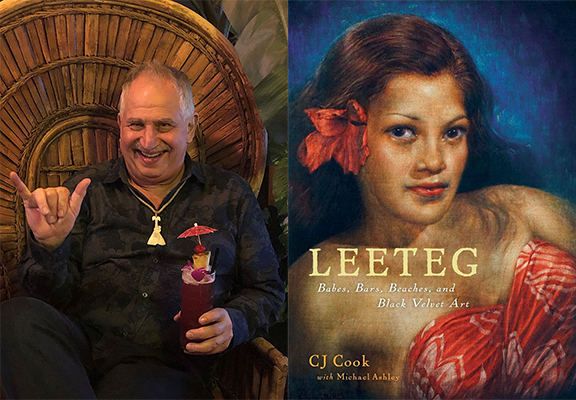
The inaugural Bernard Rosenberg Lecture will be Monday, Sept. 8 at 5 p.m. in the Peterson Room of Love Library on the University of Nebraska–Lincoln city campus. The lecture is free and open to the public.
The first lecturer is Scott Mubarak, who writes as C.J. Cook, an award-winning author and historian with a long interest in the history of the South Pacific.
His lecture is titled “Leeteg, Tyree and Rembrandt: Black Velvet Art and the South Pacific.” Black velvet is a distinctive and dramatic medium that emerged as a popular genre in the 20th century.
The technique involves applying oil paint to black velvet, which absorbs light and creates an intensely dark background, akin to the chiarascuro that Rembrandt employed. This effect allows painted subjects—often portraits—to appear luminous and three-dimensional. Although the practice has roots in ancient Kashmir and 19th century Europe, it gained widespread popularity in the middle of the 20th century, particularly in the South Pacific.
Edgar Leeteg, often called the “father of American black velvet painting” or the “American Gauguin,” was instrumental in popularizing the medium. Working in Tahiti, he began painting bold, sensuous images of Polynesian life, sparking a craze that spread to tiki bars and South Seas-themed restaurants across America, post-World War II. One of his most devoted acolytes was Ralph Burke Tyree, whose prolific portraits of Polynesian wahines spanned from 1945 to 1979.
Though long dismissed by critics as kitsch, black velvet painting has endured as a beloved form of popular art. Collectors admire its bold colors, exotic themes and nostalgic charm. Today, a new generation of artists is reclaiming the genre, recognizing its technical challenges and expressive potential within both historical and contemporary cultural contexts.
The Bernard Rosenberg Lecture is made possible with a gift to the University of Nebraska Foundation by Dr. Stuart P. and Lynn S. Embury of Holdrege, Nebraska. Stuart Embury is a graduate of both UNL and UNMC. Lynn Embury is a graduate of UNMC. The lecture is named in honor of Rosenberg, who died last year. Rosenberg lived in New York and was an expert in American art and antiquarian art books.
The son of Jewish-Polish immigrants, Rosenberg was a book dealer, art lover, archivist and businessman who believed in the transformative power of education. He established his bestselling enterprise, Olana Gallery, in 1971, specializing in rare and out-of-print American art books.
Rosenberg compiled “Olana’s Guide to American Artists: A Contribution Towards a Bibliography” and reprinted dozens of rare 19th and early 20th century exhibition and auction catalogs, making them available to scholars and the public.
Many of the books on American Art, now a part of the Stuart P. Embury, M.D., Library of American Art located in the UNL Libraries’ Archives and Special Collections (Love Library, Room 29), were acquired because of his expertise and connections. UNL Libraries received more than 11,000 books and exhibition catalogues from Embury in 2010. He amassed what is considered one of the top private book collections on American art in the United States over 40 years.
Professor of Art History Wendy Katz said this lecture series spotlights the enduring relevance of studying both manuscripts and artworks.
“Both connect us to the thoughts and hands of people in the past,” she said. “I am grateful for the efforts of Mr. Rosenberg, Dr. Embury and Dr. Mubarak to preserve these precious documents of the past, which enable students of the history of art to better understand the present.”
The Peterson Room is located in Rm. 221 of Love Library South.